Due to the massive urban sprawl Manileños have been experiencing at a rapid rate these past few decades, more and more are physically being distant from the historic center of the city. This creates for a lot of citizens a feeling of disassociation from their urban cultural history and heritage.
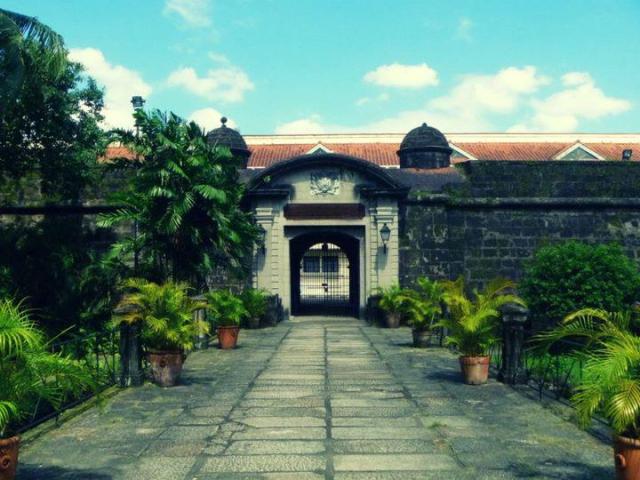
The Puerta Real, which leads to a garden. This gate was formerly used exclusively by the Governor General and the Archbishop of Manila.
Fortunately, in today’s age of the Internet, increased mobility and the leisure travel craze, more and more folks from places like Quezon City, Marikina, Antipolo, Makati, Las Piñas, Mandaluyong and all these other “provinces” of pre-war Manila are developing an encouraging sign of interest in the old capital. I am not claiming that there is increased sympathy or even, care for Manila. However, it cannot be denied that more and more youths and adults can be seen walking the streets of Intramuros and Binondo. We who work for the promotion and preservation of the city must be happy with the influx of smartphone-holding people, taking “blogger” shots here and there, and well, just visiting the remnants of what used to be “a city of affections”.
Before I get carried away and turn this entry into an essay, allow me to share with you my suggested itinerary for a trip to Intramuros. I must admit, I would prefer that people would call on me to be their guide but unfortunately, I can only do tours on weekends and holidays – upon request. This blog entry will be a helpful guide for you as you go around the historic (some squalid) streets of la ciudad murada, Intramuros, the walled city.
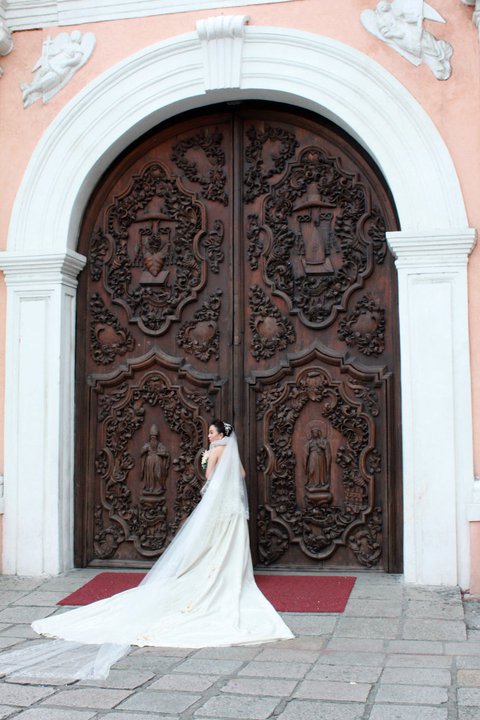
The main portals of San Agustín has been witnessing this all-too-familiar scene for roughly four hundred years now. Until today, San Agustín Church is a favorite wedding venue.
This is because sadly, getting around Intramuros can be quite overwhelming especially with the lack of signboards, directions, maps and other helpful information. You may search on Google maps directions but you’ll be hard-pressed to get information behind the streets’ names, the stories about the buildings and the historical context of certain events because well, you either didn’t pay much attention to your history classes or you simply don’t know them. Nevertheless, here’s my informative guide to half a day in Intramuros.
Allow me to even propose a time-table for this one-day tour of Intramuros for your reference and guidance. Note that I dropped Fort Santiago here as visiting it will take much of your time. You can go to it if you have a whole day set aside for Intramuros.
1:00 PM – San Agustín Church and Museum (Calle Gen. Luna)
If there is one sole original structure within Intramuros, it is none other than San Agustín Church, the only connection of any person to the history, art and culture of pre-War Intramuros. It is an exquisite repository of local Baroque designs and fixtures. Built in 1581, it is a UNESCO heritage site.
If there is one museum in Intramuros you must visit, it is this one. Inaugurated in 1975 by the former Principe de Asturias (eventually King) Juan Carlos de Borbon and former Princess Sofía, it holds a vast collection of Augustinian and ecclestiastical arts and artifacts saved through the years. The former monastery gives visitors a veritable feel of the religious life in one of Intramuros’ seven convents, with its manicured gardens and patios, stone staircase and cloister or clausura lined with religious paintings.
What you’re in for at the museum: Paintings, wooden pieces of furniture, pre-Vatican II vestments with gold thread, bronze, silver and gold works, exquisite ivory statues, centuries-old books and documents (including dictionaries of ancient Philippine languages) as well as access to the Sala de Profundis, the hair-raising crypt (occupied by some of Manila’s old rich families and historic figures including the ilustrado artist Juan Luna y Novicio) and Padre Blanco’s gardens. Currently, the coro or choirloft, which features the silladores or the carved Molave choir stalls of the friars, is closed due to conservation work. From this loft, one can view the church’s nave and get up close to the pipe organ.

Perhaps one of the most famous pieces in the San Agustín Museum collection is this statue of the Dominican martyr San Pedro de Verona who was hacked on the head by heathens.
Must sees:
– The trompe l’oeil (“fools the eye” in French) decoration of the wall and ceiling gives you the impression that the ornamentations are carved but they are actually painted. Started in 1875 by Italian opera backdrop artists Cesare Alberoni and Giovanni Dibella, the paintings are actually under threat of corrosion due to the air quality in the area.
– The side chapel of The Assumption, which you can immediately find at your left upon entering the church. It is a family crypt where most of the ancestors of the highly-influential and affluent Zóbel – Roxas – de Ayala – Soriano family are interred.
– The pulpit or ambo is an artistic piece. Elaborately gilded, it is located at the right side of the church (if one is facing the sanctuary) and holds a position of prominence since in the old days, when the microphone was still non-existent, the priest used to give sermons from the canopied structure. It has native flora and the pineapple as its decorative motifs.
– The Chapel of the Conquistadores – located at the left side of the sanctuary, the sarcophagus of the founder of the city of Manila, el adelantado, Miguel Lopez de Legaspi, figures in the middle. It contains the mortal remains not only of Legaspi but also the other pioneer conquistadores who used to be buried in the church but whose bones were scatted when the British pillaged the church during their occupation from 1762-64.
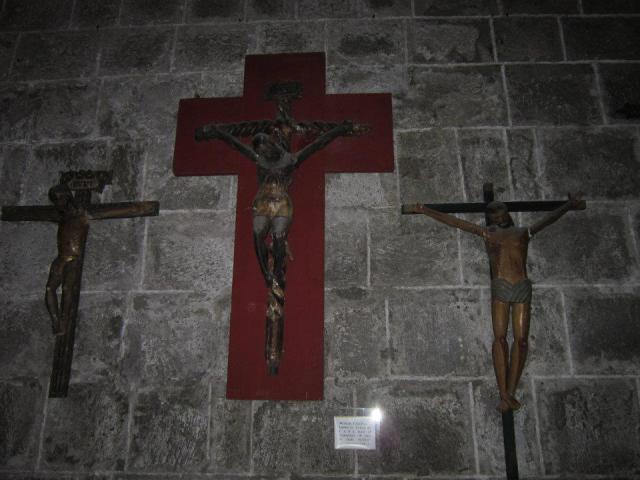
The refectory (which I still is under conservation work) is located across the crypt. It houses the Pagrel collection, part of donation of Don Luís Araneta to the museum.
Tips:
– The museum opens at 8:00 AM and has a lunch break from 12:00 PM to 1:00 PM. It closes at 6:00 PM.
– The entrance fee for adults is at Php 200 while students should bring their IDs so that they would only pay Php 100.
– If you don’t have time or you don’t want to go to the museum but you want to see the church, you can enter the church at 5:00 PM.
– You would usually see the doors flung open but that’s because there’s a wedding. You can only stay at the narthex if there are religious ceremonies going on.
– Don’t be in a rush when you do the museum tour. Take your time as you read through the descriptions and marvel at the fine craftsmanship of Filipino and Chinese artisans.
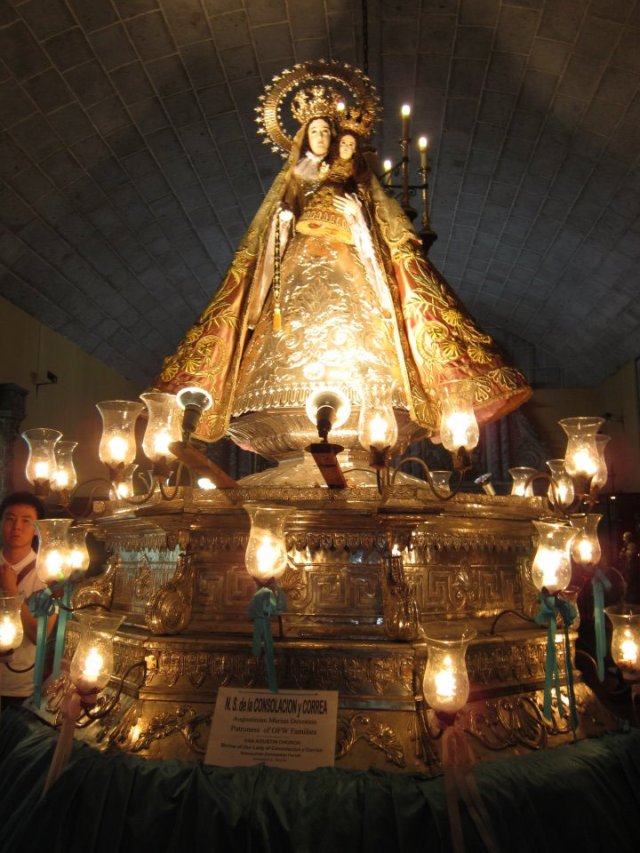
A sumptuous image of Nuestra Señora de la Consolación y la Correa, patroness of the Augustinians in the Philippines, wearing hammered silver and gold thread vestments mounted on a silver-plated carroza – one of the many images you can see in the museum.
2:00 PM – Plaza San Luís Complex
A reconstructed compound, it resembles a Spanish colonial residential enclave. Entering it gives you a semblance of what it was like to enter the mansions of pre-War Intramuros. Currently, it houses souvenir shops and Barbara’s, one of a few dining options in Intramuros. Although the Barbara’s in the upper floor is quite formal in set-up, you can enjoy a more relaxed dining experience at the first floor, surrounded by plants and white-washed stone walls. Sometimes, rondalla music would accompany you here.
Tips:
– This is a good spot to catch your breath after the tour of San Agustín. Catch a cup of coffee and have some heavy pancit (stir-fried noodles) as you rest your feet for a few minutes and bask in the old colonial world feel of the place.
– Casa Manila is located within Plaza San Luís. It is a museum that depicts the classic colonial residence of a middle-class Filipino family. It has beautiful furnishings. However, the museum’s stiff restrictions (i.e. because of the polished wooden flooring, you are only allowed to walk on the red carpet, which also serves as the route of the museum visit; no photographs allowed, etc.) can be a turn-off. Also, if you’ve been to other old houses in the country, this might pale in comparison. But for first-timers, I suggest you go and see it for yourself. It isn’t something though you’d be coming back to.
– Entrance fee: Php 75.00
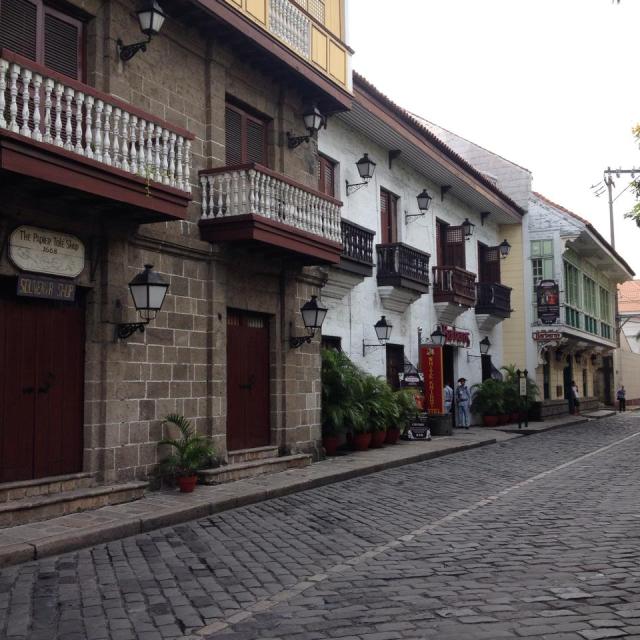
The portion of Calle Luna in front of Plaza San Luís has cobbled stones, giving you a real feeling it’s a well-preserved area of Intramuros.
Trivia: The whole area is not original. Because of the excellent work initiated by the former First Lady Imelda Marcos, visitors get the impression they’re in an historic compound.
2:30 PM – Memorare Monument (Plazuela de Sta. Isabel, Calle General Luna cor. Calle Anda)
Serving as a common gravestone to the 100,000 innocent civilian men, women, children and infants who were killed during the Liberation of Manila in February 1945, it is a somber stop in tours I give. It remembers the unjust, cold and bloody murder of Filipinos, Spaniards, and other persons living within Manila during the time when they were supposed to be freed from the Japanese. Scuplted by Peter de Guzman, the memorial was unveiled in 1995 on what used to be a girls’ school’s plaza. The merciless murders perpetuated by the Japanese Imperial army during its last day in Manila caused severe trauma to the city’s original residents, compelling them to leave their once beautiful city, and transfer to the suburban, almost provincial areas of San Juan, Pasay, New Manila, Quezon Avenue, and eventually, Makati.
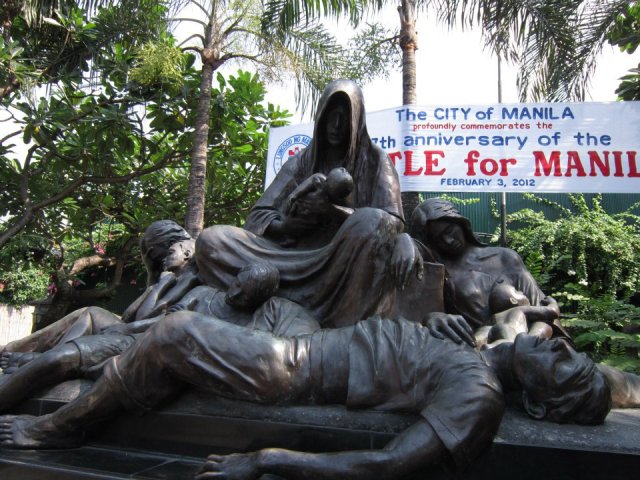
A sobering stop reminding tourists that Intramuros was witness to some of the most violent and terrifying chapters in human history. Manila was the second most destroyed city after Warsaw during World War 2. It lost forever its charm, its very soul.
2:45 PM – Plaza de Roma (Calle Aduana/Andres Soriano Avenue cor. Calle Real del Palacio/Gen. Luna Street)
Located at a strategic area in Intramuros, Plaza Roma was formerly Plaza Mayor, the “queen” of all plazas in the country, which was surrounded by the former Palacio del Gobernador, the Ayuntamiento (which was recently reconstructed rather tastefully) and the Manila Cathedral, the “mother” of all dioceses in the Philippines. One must remember that Intramuros was the city of Manila; thus, Plaza Mayor, being the main public square of the capital, it was once a busy and important open space, similar to all the major squares in European cities. Why, even bull fights were held here. Eventually, it was transformed into a garden, and today it is a manicured garden graced at the center of a bronze statue of King Carlos IV, the Spanish monarch who sent the vaccine against small pox to Spain’s only colony in the Far East. The said statue was erected in 1824. The plaza’s current name – Plaza de Roma – in in honor of the Eternal City of Rome, and the change was brought about in 1961 when the first Filipino was elevated as a Prince of the Church (cardinal), the aristocratic Archbishop Rufino Jiao Cardinal Santos.
3:00 PM – Manila Cathedral or formally the Catedral Basílica Metropolitana de la Inmaculada Concepción de Santa María (Calle Gen. Luna cor. Postigo)
Destroyed during the Liberation of Manila in 1945, the current building was rebuilt in 1958 through the efforts of the first Filipino Cardinal, Archbishop Rufino Cardinal Santos. The 8th cathedral building to stand on the same spot, it was designed in the neo-romanesque style by a team of Filipino and Italian artists under the supervision of notable Filipino architect Fernando Ocampo. Technically, the Manila Cathedral as an establishment has been around for 430+ years.
Three Popes have celebrated Mass here: Blessed Paul VI, St. John Paul II and most recently, Pope Francis. Beneath the cathedral is the crypt where past archbishops of Manila are buried. The reason why this church is important is because all the other archdioceses and dioceses in the country were technically established by the Archdiocese of Manila. The church also houses the biggest pipe organ in Asia.
Must sees:
– The replicas of la Pieta and San Pietro statues, the original ones being iconic artworks in St. Peter’s Basilica in Rome.
– The mosaics. Not many notice the exquisite mosaic works that grace the side chapels of the cathedral. These mosaics were executed by Italian artists and some of them are accentuated with gold leaf. The ceiling of the canopy in the sanctuary is also decorated with gold leaf mosaic.
– The cardinal’s galero or red hat which hangs from the dome. It is a sign that a church is a cardinal’s church.
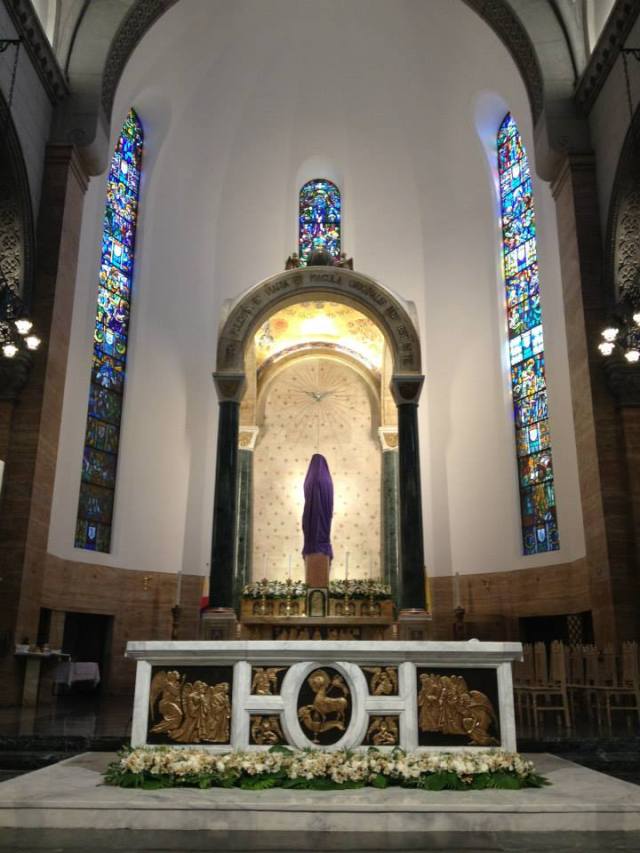
A view of the sanctuary of Manila Cathedral with the image of Our Lady veiled as customary during Holy Week.
Trivia:
– The statue of Our Lady of the Immaculate Conception in the altar used to be painted totally in gold. However, since it was too glaring, almost gaudy, they repainted it.
– The Manila Archdiocese used to be a parish of the Archdiocese of Mexico.
– The cross on the dome of the Manila Cathedral used to be the Philippines’ “Kilometer Zero”, the reference point from which all distances were measured.
– Its bells are the largest in use in the whole country.
– Its pipe organ is the biggest in Asia.
3:30 PM – Ayuntamiento (Formerly Calle Aduana/Andres Soriano Avenue)
The Ayuntamiento or the former City Hall made a recent comeback to the walled city when it was reconstructed on its original site to house the Bureau of Treasury. It is a rather tasteful reconstruction project, and its main hall is a beautiful place to hold an event.
The Ayuntamiento served as the palace of the Manila City Council, which consisted of two alcaldes (city leaders), eight oidores (judges), a clerk, and a chief constable. This set-up was also the precursor of the current Supreme Court. The First Philippine Assembly and the eventual Philippine Legislature also held sessions here. It was destroyed in 1945 with only the outer walls of the original building left standing, and for practically 60 years, it served as parking lot. In 2009, reconstruction began and was completed albeit delayed in 2013.
Trivia: It used to be known as the “Marble Palace” because of its generous use of Romblon marble.
Tip: You really can’t enter the building because it’s an office and not a tourist site.
3:45 PM – Intendencia/Casa de Moneda/Aduana (Muralla cor. Calle Aduana/Andrés Soriano Avenue)
This building serves as a “what-if” reminder to visitors in Intramuros. You see, after the Liberation of Manila (World War II), not all the structures were flattened. Most of the facades and outer walls of the churches, convents, palaces and buildings remained. This was one such example. The unfortunate tearing down of old buildings took place through the decades particularly in the 50s and 60s. Intramuros could have been a city of wonderful if not, hair-raising facades!
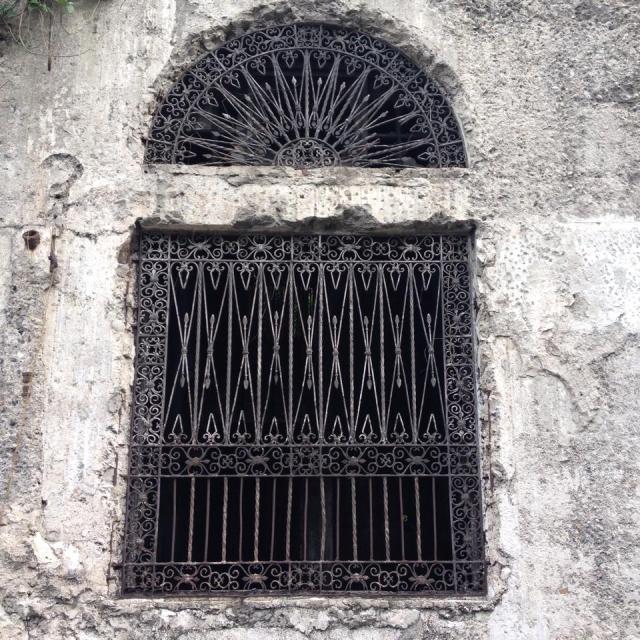
Some of the remaining wrought iron fixtures in the building. Thankfully, not all have been stolen by junk peddlers.
The Intendencia used to be customs house of the country. Inspectors of the galleons that would enter the Pasig River would hold office here. This was also where the first Philippine currency was minted after we stopped using Mexican silver after Mexico’s independence from Spain.
Actually, the building was still used after the War and was conserved to function as the offices of the Central Bank, the National Treasury and the Commission on Elections. However, in 1979, a fire ravaged the building. Currently, it serves as a picturesque albeit creepy backdrop with its remaining elaborate wrought iron grills, arched doorways and sparsely-decorated Baroque façade. Trees, ivy and plans have grown inside the edifice.

Plaza Mexico is very near the Intendencia. One can make a stop to visit this monument celebrating the long ties that bind Mexico and the Philippines.
Trivia: The first Philippine Pesos were minted here. They called our money “pera” in reference to “perra” (bitch), as it bore the face of the unpopular Reina Isabela II.
4:00 PM – Muralla Walk
This portion of my tour takes you on the actual adobe stone walls of Intramuros as you walk the periphery. Coming from the Intendencia, you make your way down to el Colegio de San Júan de Letran whose high school department is the oldest suriving in the country.
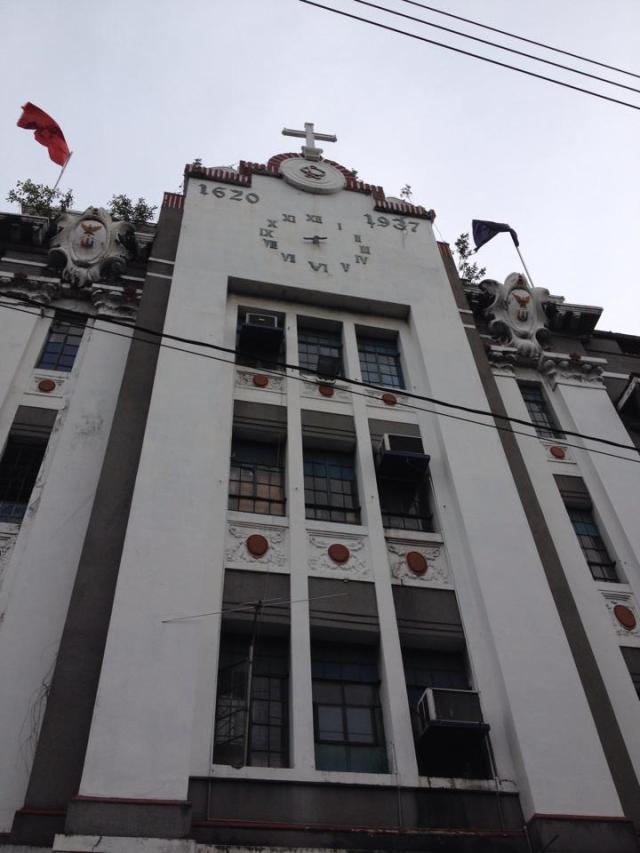
The clock tower of Letran bears the date of establishment and the date when the “new” building was erected (1937).
You ascend the walls in front of Letran and walk on it, passing by the Puerta del Parían near Lyceum.
Upon reaching Mapúa College, you may take time to take photographs at the palisade replete with cannons.
Trivia:
– The walls of Intramuros are made from adobe stones quarried from Guadalupe, Makati and transported through the Pasig River. The project of fortifying the city with stone was initiated by a Jesuit, Padre Antonio Sedeño, SJ, after whom the Salcedo Village street was named.
– The Mapúa compound used to be the Franciscan friars’ section of the city, occupied by the Iglesia de San Francisco and the Capilla del Venerable Orden Tercero (VOT) or the Chapel of the Third Order, the lay arm of the Franciscans.

You can walk on the walls of Intramuros. This activity gives you a nice vantage point to view different aspects of the walled city as well as its peripheries, just like the soldiers of yore.
4:30 PM – Sunset at Bayleaf Hotel’s Skydeck
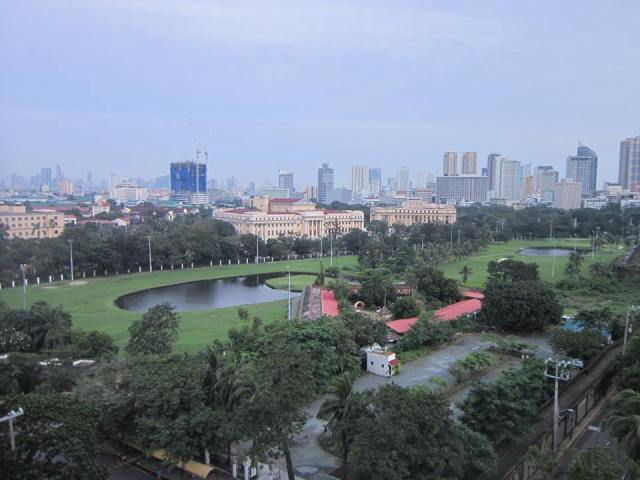
A view of the Intramuros golf course, the National Art Gallery and Natural Sciences Gallery from Bayleaf Hotel’s Skydeck
To end your tour of the “ciudad insigne y siempre leal” – “the distinguished and ever loyal city” (a royal appellation given by the King of Spain to Manila/Intramuros), go to the penthouse level of the Bayleaf Hotel (owned by the Laurel family).
This restaurant deck affords you a 360-degree view of Metro Manila. On good days, you can marvel at the iconic Manila sunset as you enjoy cold drinks to end your tour.

End your tour of Intramuros with a cold drink at Bayleaf Hotel. If the weather permits, you will be able to enjoy fantastic views of the sun setting over Manila Bay.
If you have more time for Intramuros, I suggest you also visit:
1.) Baluarte de San Diego – an archeological site, you can pay a measly Php 75 to enter the grounds, which also include a bonsai garden and access to a portion of the bulwark that affords you a great view of the former Beaterio or convent of the Religious of the Virgin Mary, which is now the Lights and Sounds Museum.
2.) Fort Santiago – the former military headquarters during the entire 300-year rule of the Spaniards, this has been transformed into pocket gardens and parks, an idyllic tourist and event venue. The former main gate which bears the bas relief of Santiago Matamoros (St. James Slayer of the Moors), patron of Spain, still stands.

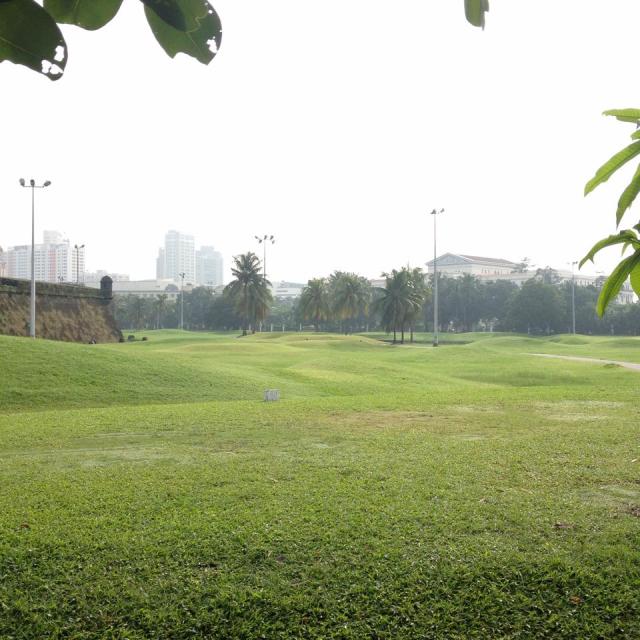
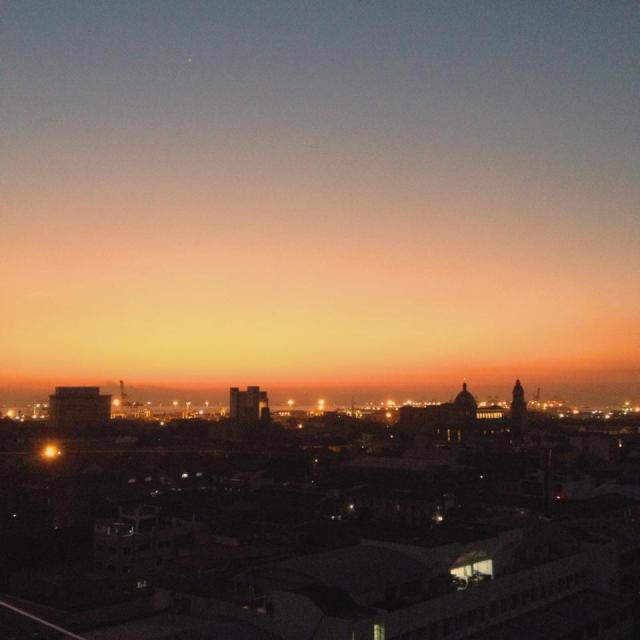
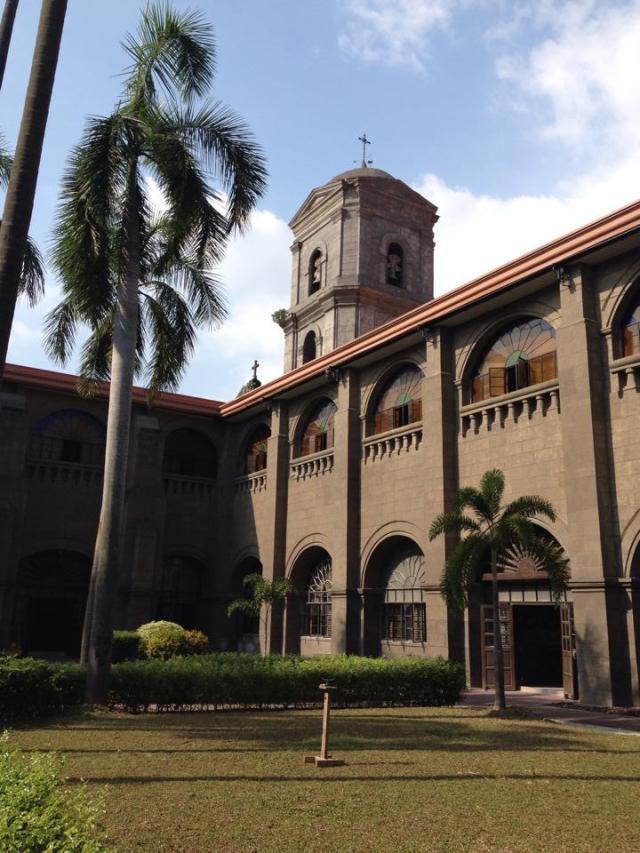
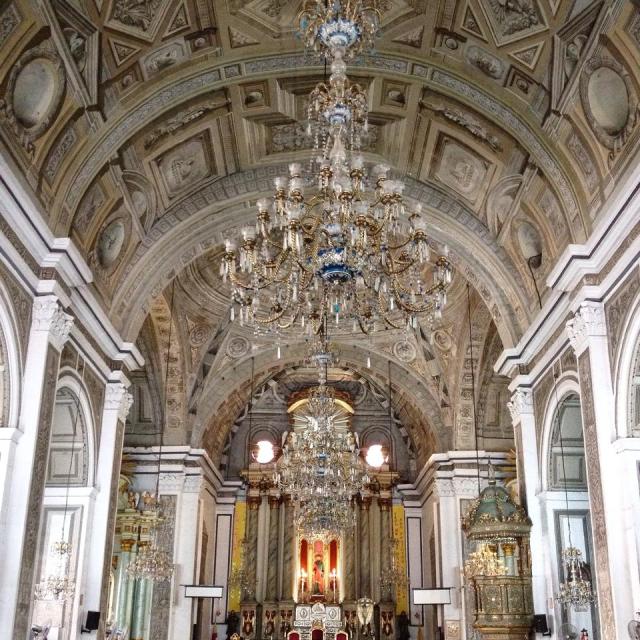
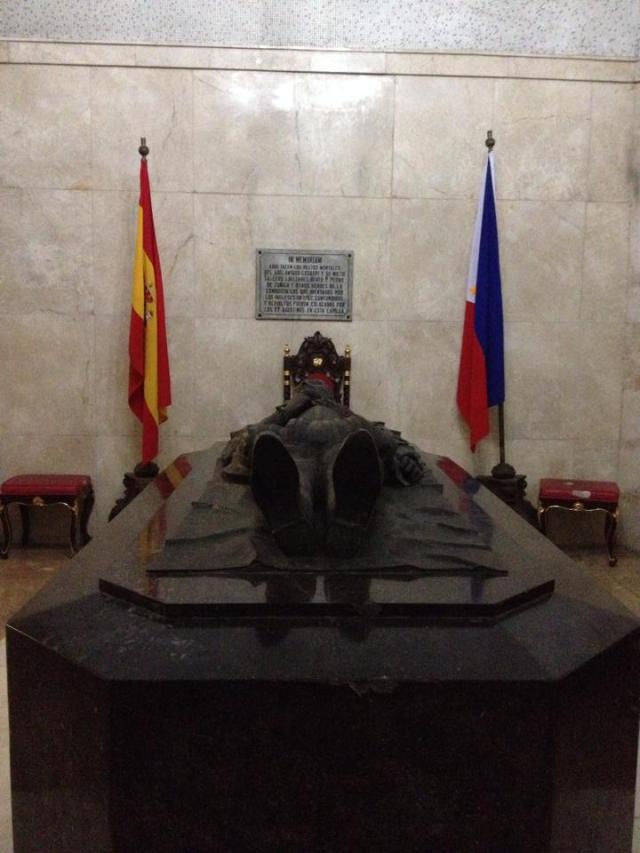

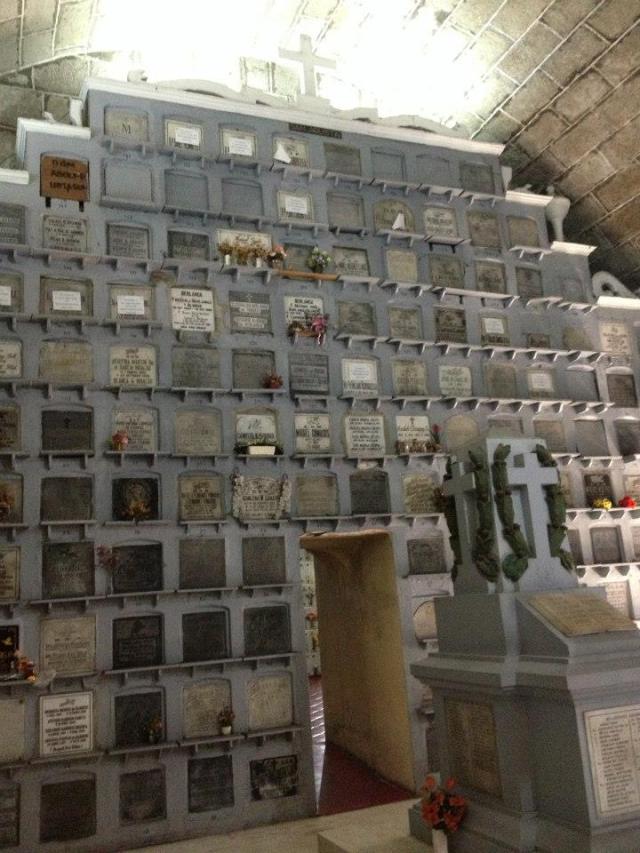
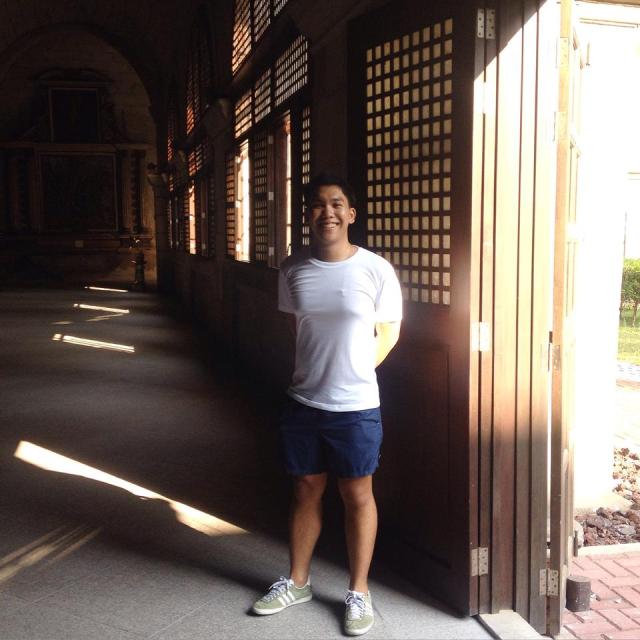
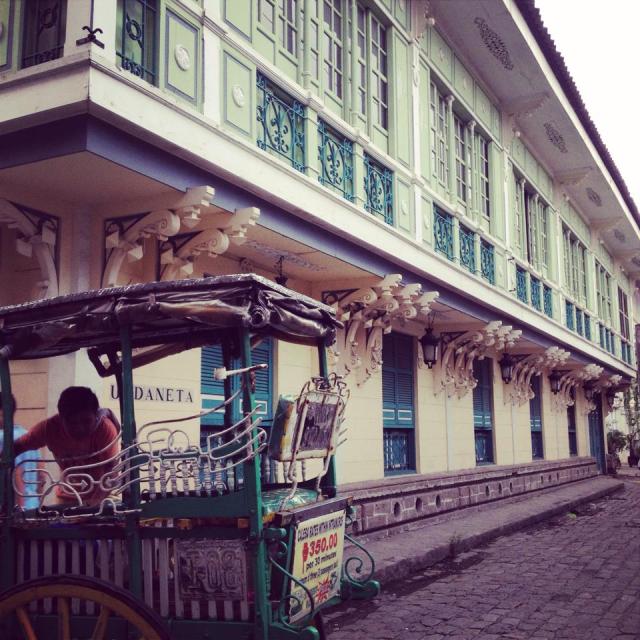
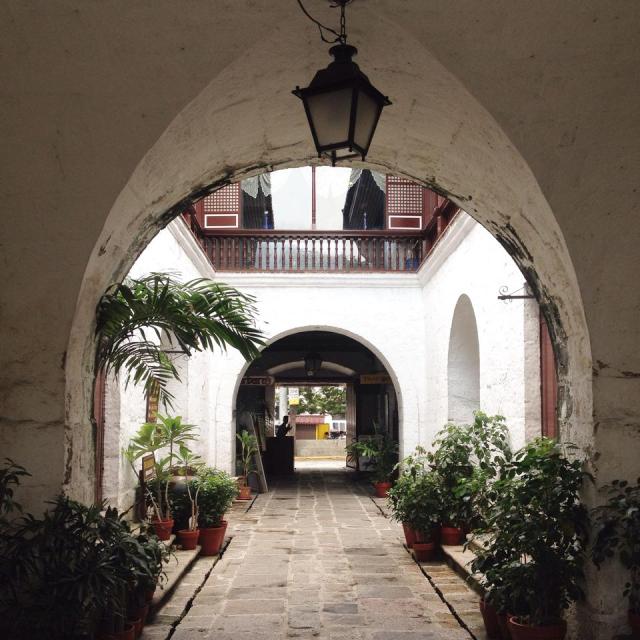

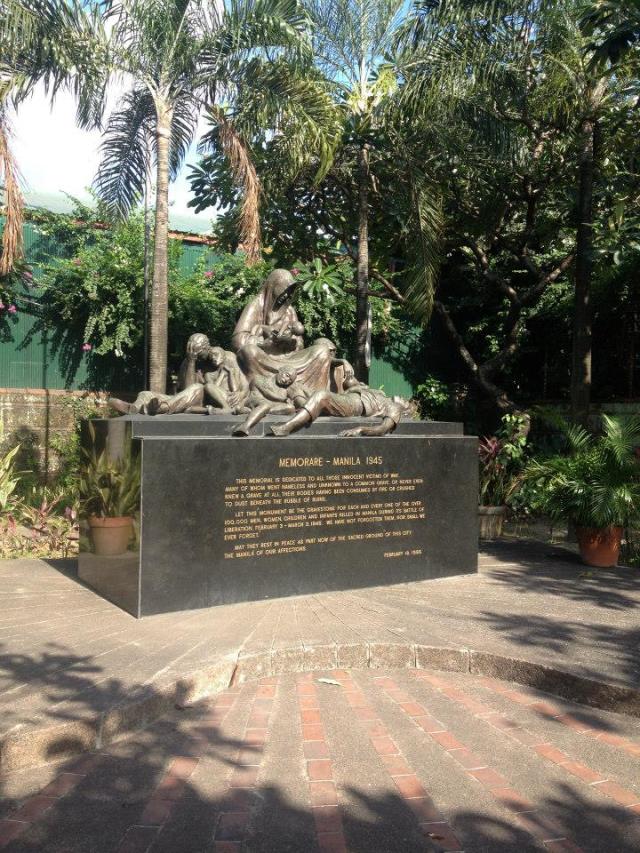
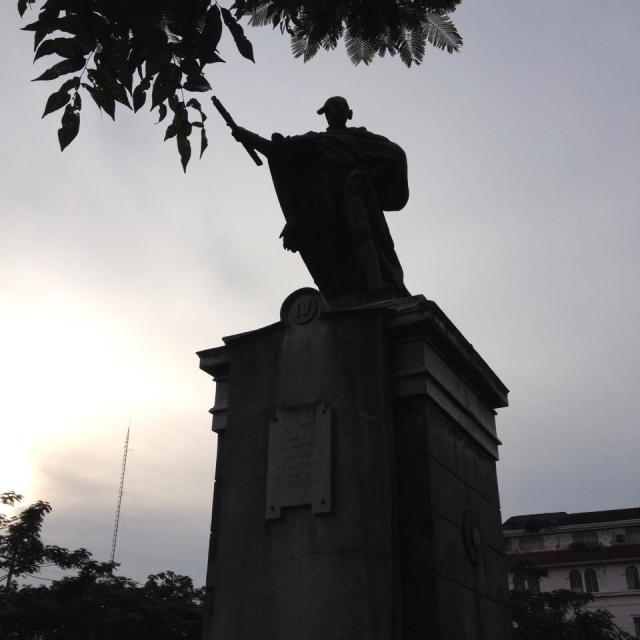
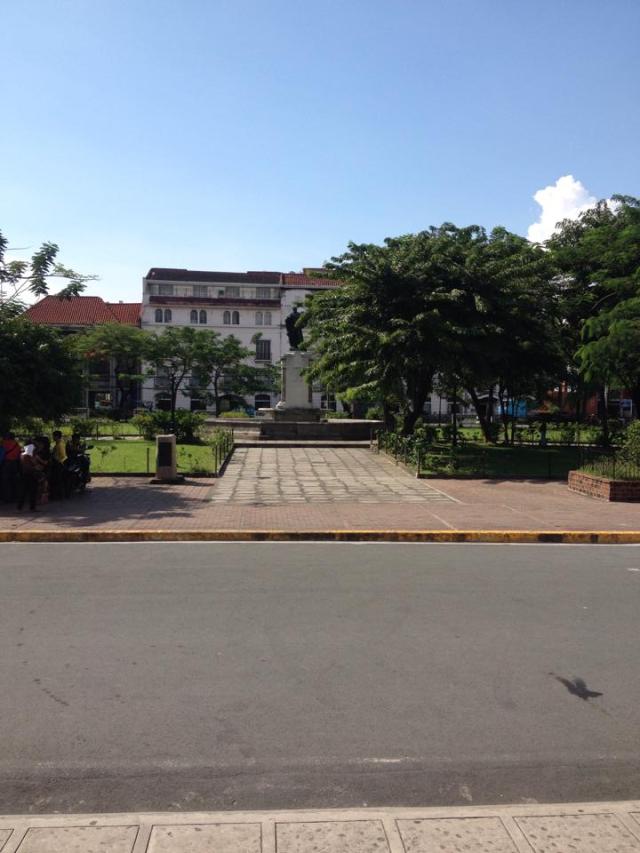
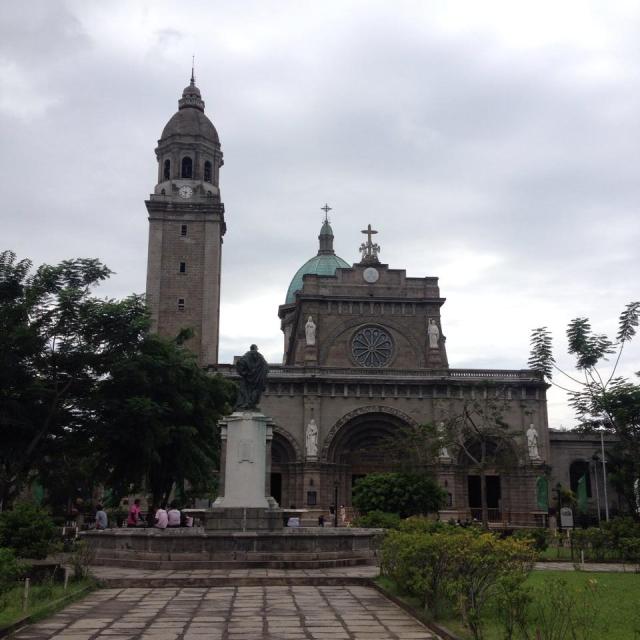
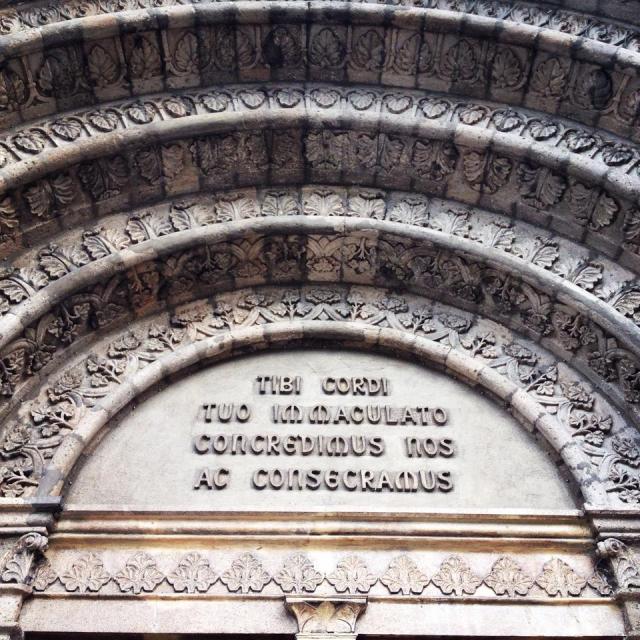
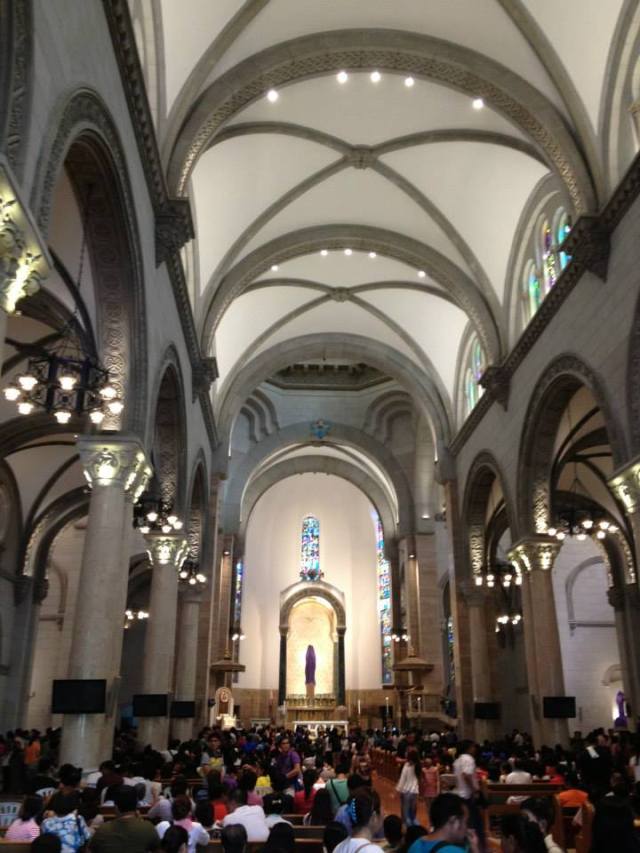


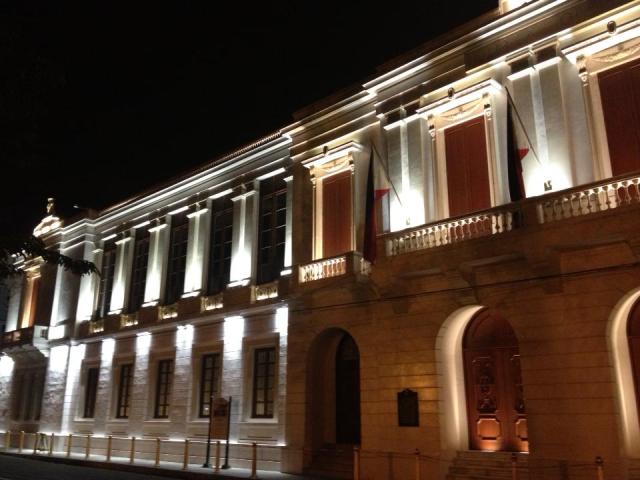
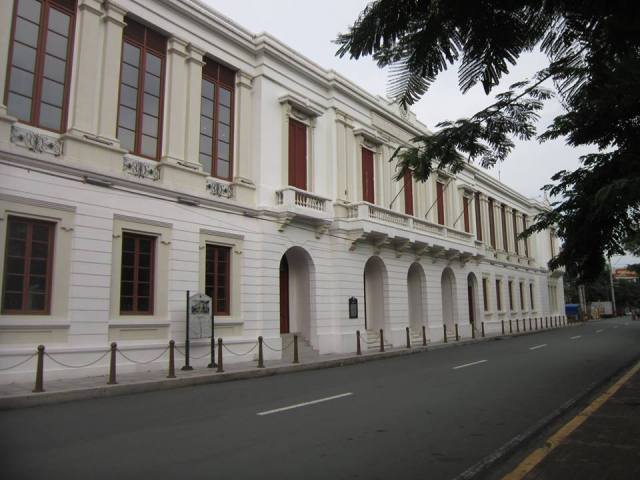

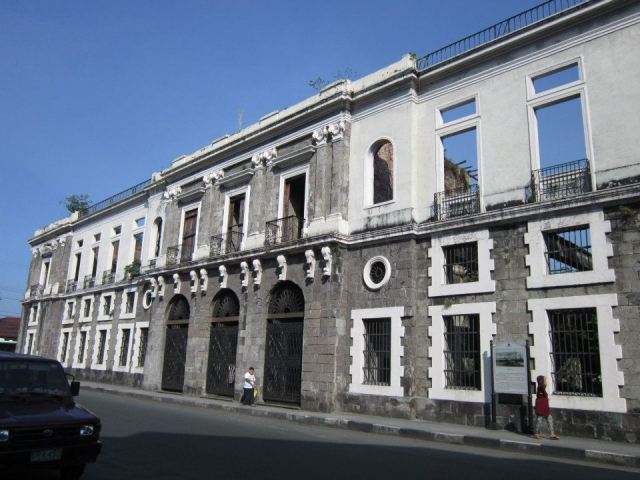
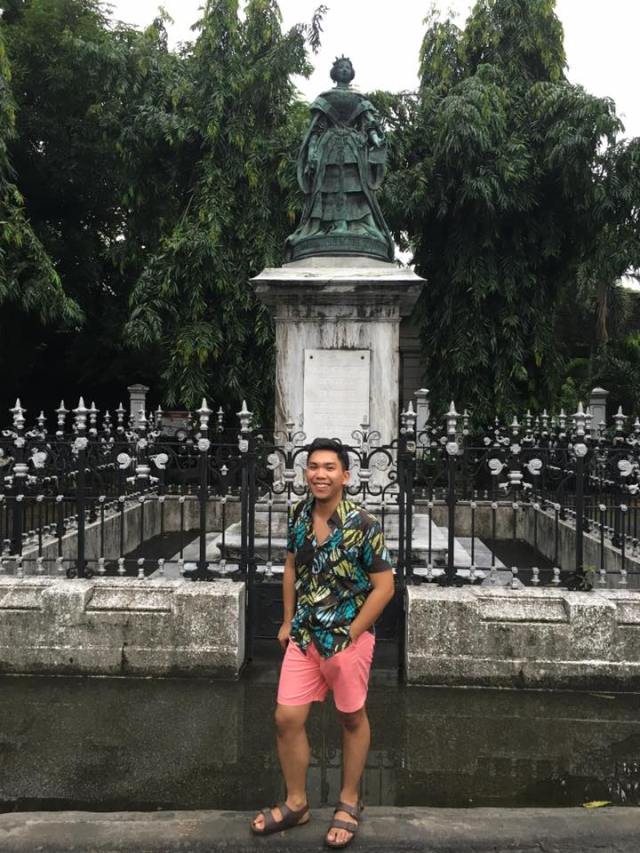
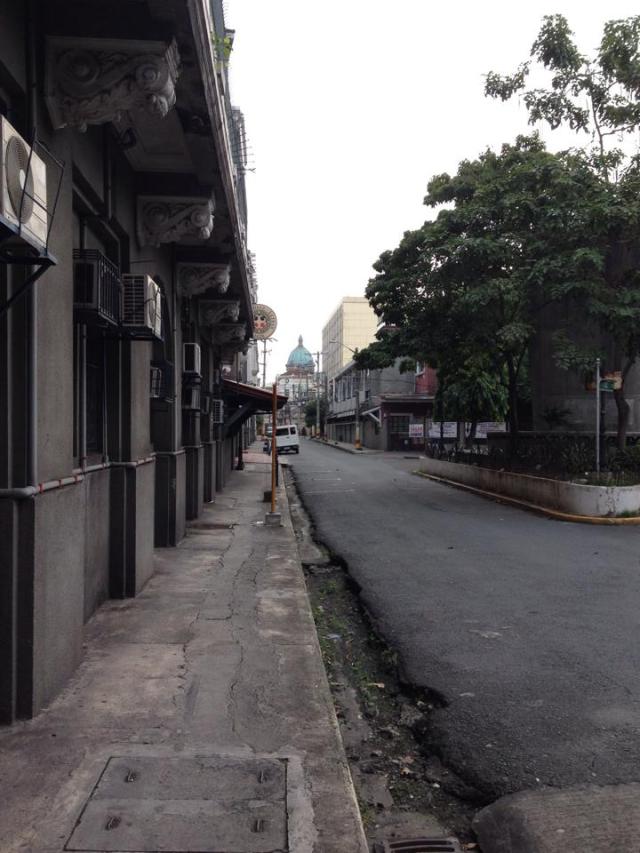
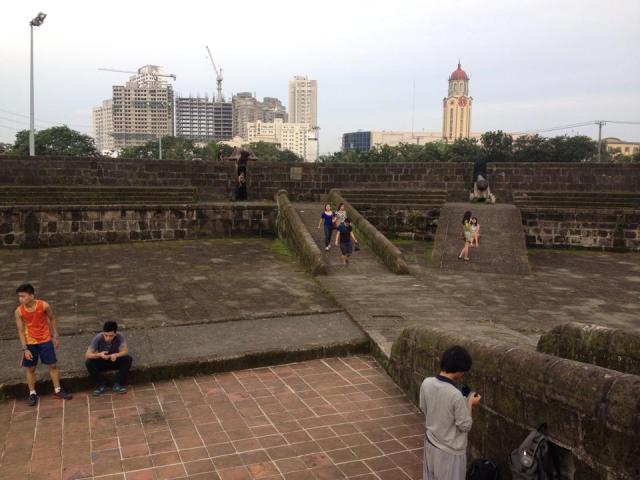
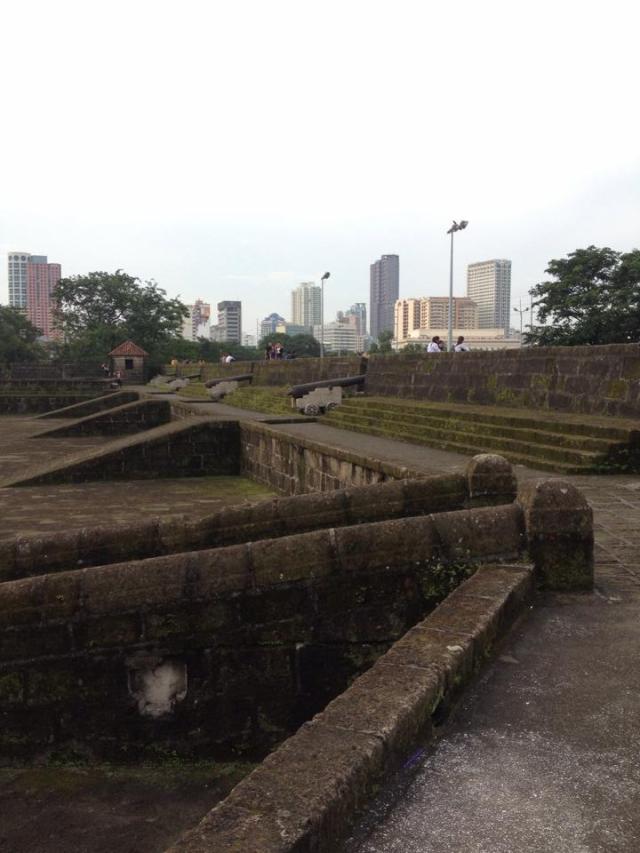

Hi. Do you do Intramuros MM tour? You have a number where you can be reached?
Hello, yes, I do give tours in Old Manila. These are mostly cultural, walking tours. I sometimes cater to those who want to see other parts of modern Manila but I never include malls.
HI please send me a quotation for a guided tour in Intramuros. Thank you!
Hi my rates depend on the number of people participating.